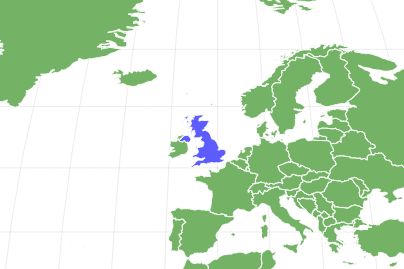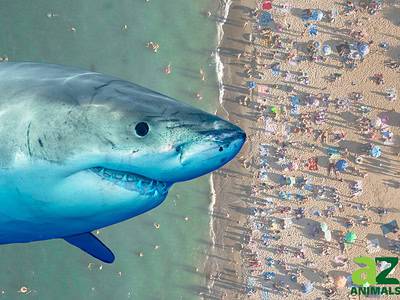Scottish Terrier
Canis lupus
This breed is nicknamed the “Diehard” because of its iron will and steely determination.
Advertisement
Scottish Terrier Scientific Classification
- Kingdom
- Animalia
- Phylum
- Chordata
- Class
- Mammalia
- Order
- Carnivora
- Family
- Canidae
- Genus
- Canis
- Scientific Name
- Canis lupus
Read our Complete Guide to Classification of Animals.
Scottish Terrier Conservation Status
Scottish Terrier Facts
- Fun Fact
- This breed is nicknamed the “Diehard” because of its iron will and steely determination.
- Temperament
- Confident, independent, and alert
- Diet
- Omnivore
Scottish Terrier as a Pet:
- General Health
- Energy Level
- Shedability
- Trainability
- Intelligence
- Tendency to Chew
- Size
- Family and kid friendliness
- Yappiness / Barking
- High
- Separation Anxiety
- Moderate
- Preferred Temperature
- Average climate
- Exercise Needs
- Moderate
- Friendly With Other Dogs
- Moderate
- Pure bred cost to own
- $800 on average
- Dog group
- Terrier
- Male weight
- 19-22 lbs
- Female weight
- 18-21 lbs
This post may contain affiliate links to our partners like Chewy, Amazon, and others. Purchasing through these helps us further the A-Z Animals mission to educate about the world's species.
View all of the Scottish Terrier images!
The Scottish Terrier can be crossed with other breeds to produce unique mix or designer dogs, like the Mini Scottish Fox Terrier or the Scottish Cocker.
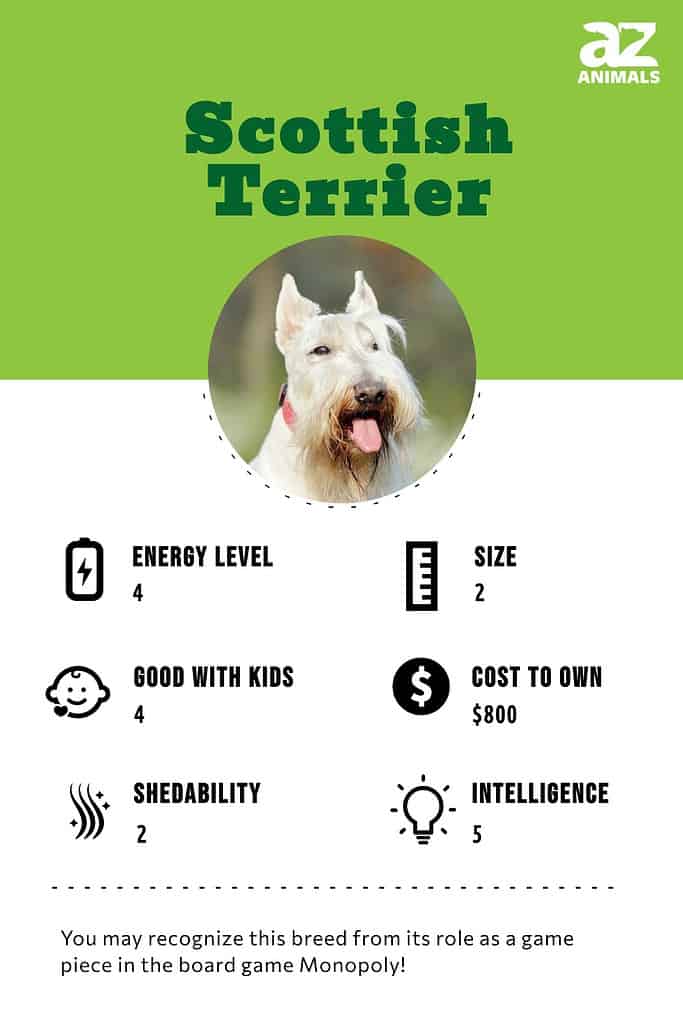
Origin
The Scottish Terrier is a small, stout legged breed with plenty of confidence and personality to compensate. It was first bred in the Scottish Highlands, sometime around the 1400s, to hunt for vermin and small game such as badgers. Scotties developed strong tails so that their owners could pull them out of the tunnels that they burrowed.
See all of our expert product reviews.
The word terrier comes from a Latin word that roughly translates to “earth dog,” perhaps in reference to their practice of hunting with their noses to the ground. The first of this breed to be recognized by the American Kennel Club was a pooch known as Dake in 1884. It wasn’t until the 1930’s that the dog’s popularity in the United States began to skyrocket after several notable celebrities, as well as the president, all became loyal Scotty owners.
The Scottish Terrier has a distinctive appearance, with its well-defined eyebrows and beard, which some may say make it appear old and wise. The dog’s coat combines two different layers: a coarse, wiry outer layer and a dense, soft lower layer. It comes in a mix of a few different colors, including all black, a pale yellow or almost white color called wheaten, and a striped or irregular pattern called brindle. Little information has been gathered as to the genetic history of this breed, accounts from 15th century Scotland are the oldest records that we have.
3 pros and cons of owning a Scottish Terrier
| Pros! | Cons! |
|---|---|
| Lively and Spirited This small dog has a big, endearing personality. | Stubborn The Scottish Terrier may resist certain training methods unless you know how to handle them. |
| Adaptable The Scottish Terrier can live in a variety of different settings. | Wary of Strangers This dog has a natural tendency to be distrustful toward strangers. |
| Alert and Intelligent The Scottish Terrier is always alert and aware of its surroundings, which could make it a good watchdog. | Tendency to Wander The Scottish Terrier loves to explore its surroundings. |
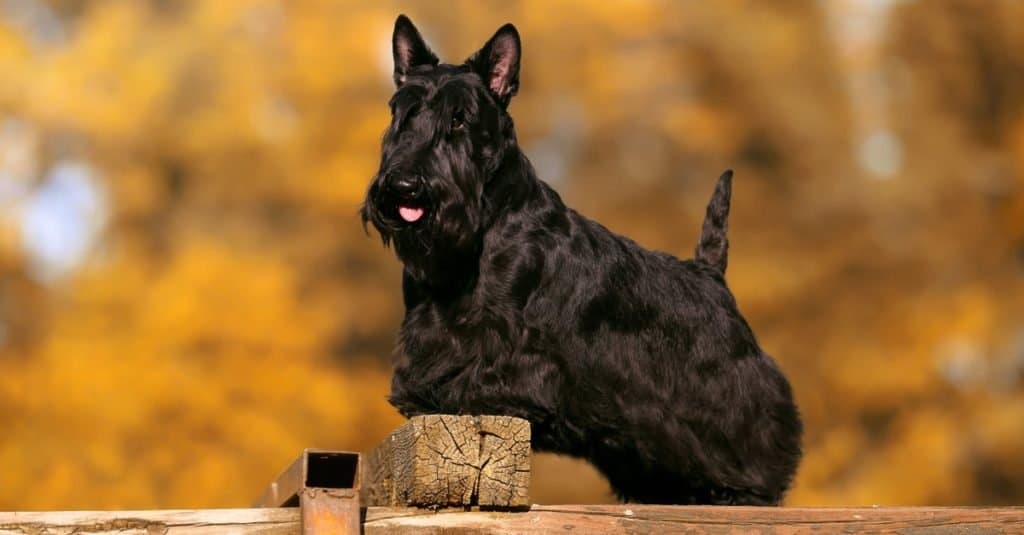
Scotties are adaptable dogs and can be happy with many different lifestyles.
©SubertT/Shutterstock.com
Scottish Terrier Size and Weight
The Scottish Terrier is a miniature but sturdy breed with short legs and a low frame. Males and females are approximately the same sizes.
Health and Entertainment for your Scottish Terrier
See all of our expert product reviews.
| Height (Male) | 10 inches |
| Height (Female) | 10 inches |
| Weight (Male) | 19 to 22 pounds |
| Weight (Female) | 18 to 21 pounds |
Scottish Terrier Common Health Issues
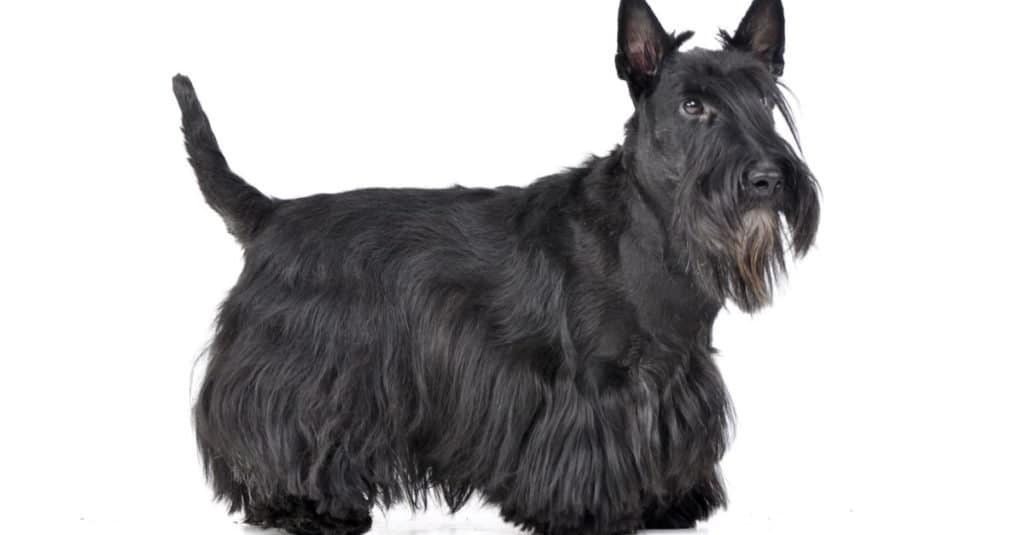
Scotties are known to cramp up when they get too excited.
©iStock.com/vauvau
The Scottish Terrier is a fairly healthy dog with an average lifespan of around 12 years. This breed is most prone to cancer, cataracts, glaucoma, craniomandibular osteopathy (a genetic condition causing excessive bone growth in the lower jaw), and a unique condition called Scotty cramp (which can cause spasms throughout the dog’s body, sometimes preventing it from walking). On the first visit to the vet, it is also recommended to have separate tests for Von Willebrand’s disease (a bleeding disorder caused by low clotting proteins) and patella (kneecap) issues. To sum up some of the most common health problems:
- Cancer
- Cataracts
- Glaucoma
- Kneecap problems
Scottish Terrier Temperament
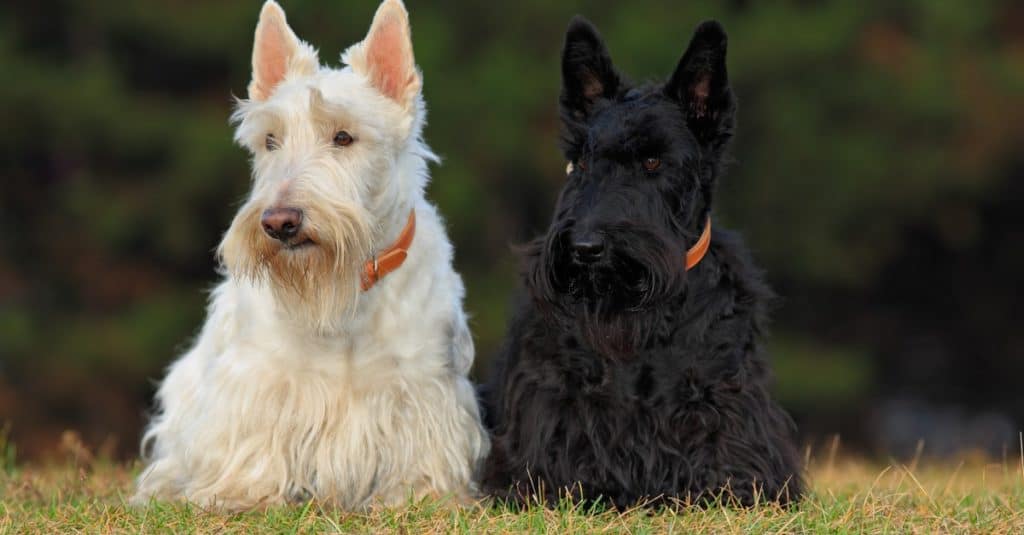
Scottish terriers have a distinguished, stoic personality to match their mustache.
©Ondrej Prosicky/Shutterstock.com
The Scottish Terrier has a strong, independent, and indelible personality that some have described as almost human like. Its confident and tenacious demeanor seems to belie its miniature size. This makes them surprisingly good watchdogs. When a stranger approaches the home, it may try to bark and alert its owner. But unless properly trained from an early age, they can be a little distrustful of and aggressive toward strangers. Their relationship with other dogs can be contentious as well, and sometimes their hunting instinct will take over and cause them to chase smaller animals. That is why it’s crucial to socialize it as a puppy to avoid these behaviors. Fortunately, the Scottish Terrier doesn’t require too much space, so they are able to live in both apartments and houses without any problems.
How to Take Care of the Scottish Terrier

Scottish terriers are a bit too much to handle for inexperienced dog owners.
©Anna Tkach/Shutterstock.com
The Scottish Terrier is a better choice for experienced dog owners than first-time owners (particularly due to difficulties with training), but anyone who’s willing to put in the time and effort can end up loving this breed. If you decide that this breed is right for you, then you should try to find a high-quality breeder in your area that adheres to the breed standards and only breeds the best dogs. Another good option is a rescue or adoption group that takes in this breed. Rescue groups care quite a bit about the health of their dogs. Once you bring your dog home, it will need regular, semi-frequent physical examinations at the vet to check for any abnormalities and problems. If you have any other concerns about the dog’s routine, then you should consult with the vet.
The Best Dog Food for Scottish Terriers

The Scottish Terrier should thrive on about a cup of dog food per day, depending on its size, age, and activity level. The American Kennel Club recommends a diet consisting of about 25% protein with a bit of canned food added in. If it’s fed the right diet, then the dog’s coat should be smooth and healthy with no signs of flaking.
To prevent some of the most prevalent health issues in Scottish Terriers, a well-rounded diet is essential.
That’s why the A-Z Animals choice for best Scottish Terrier dog food is Hill’s Science Diet Dry Dog Food, Adult, Small Paws for Small Breed Dogs.
Made for little dogs, this vet-approved dog food adds beta-carotene, taurine, and Vitamin A to your dog’s diet for healthy eyes and to keep cataracts and glaucoma at bay. Plus, the omegas nourish Scottish Terriers’ skin and coats. It’s made with quality chicken and rice for protein and calcium to keep small dogs active and fun-loving.
Check Chewy and Amazon for this product.
- Chicken and rice formula for small breeds Adult 1-6
- Omega 6 fatty acids and vitamin E for healthy skin and shiny coat
- Natural ingredients and antioxidants for immune health
Maintenance and Grooming
The Scottish Terrier needs to be brushed with a simple pin brush and comb around two to three times per week to prevent tangling and matting. Wiry-coated breeds like the Scottish Terrier should also be hand stripped once a month or so. Hand stripping is a method of removing dead hairs from the top layer by hand. This will keep the consistency of the entire coat intact.
Otherwise, if the coat is merely clipped, then it will lose some of the harsher outer layers as the softer lower layer will become dominant. If you are having trouble hand-stripping the fur yourself, then you might want to find a professional who will do it, but you should be aware that not all groomers will be familiar with this method. Besides attending to its grooming needs, you should brush the dog’s teeth, preferably every day, using a soft-bristle brush and canine toothpaste. You should also perform regular ear checks and give occasional nail trimmings whenever the need arises.
Training
The Scottish Terrier has an independent and stubborn streak that has earned this dog an unfair reputation as difficult to train. But in fact, this breed is very alert, inquisitive, and responsive to human commands. The main problem is that the Scottish Terrier has a tendency to become bored very quickly. It does not respond well to repetitive, mind-numbing tasks. Instead, it likes to exercise its mind and creativity. This means owners should limit training sessions to 15 minutes each time and try to constantly change the routine to prevent boredom. Scottish Terriers are very attentive to changes in the human voice and respond best to positive reinforcement methods. If you are struggling a bit to train this breed, then you might want to enlist the help of a professional trainer.
Exercise
The Scottish Terrier needs around a moderate amount of exercise, or around 30 minutes, every single day. Fortunately, this dog does not require a lot of space. While a yard or park is always welcome to stretch its legs, the Scottish Terrier will enjoy playing with balls and toys around the home. It should also be taken on short walks or jogs while on a leash at least for a little bit each day.
Puppies
It is always recommended to purchase puppies from high-quality breeders or rescue organizations that really care about the health of their dogs. Puppies should never be purchased from low-quality breeders and puppy mills, which are more likely to overlook health problems. You should also be prepared for the puppy’s training. Within the first few months of its life, the Scottish Terrier needs proper socialization to overcome its natural tendency to distrust strangers. Training sessions, dog parks, and gatherings with families and friends are all excellent places to start.
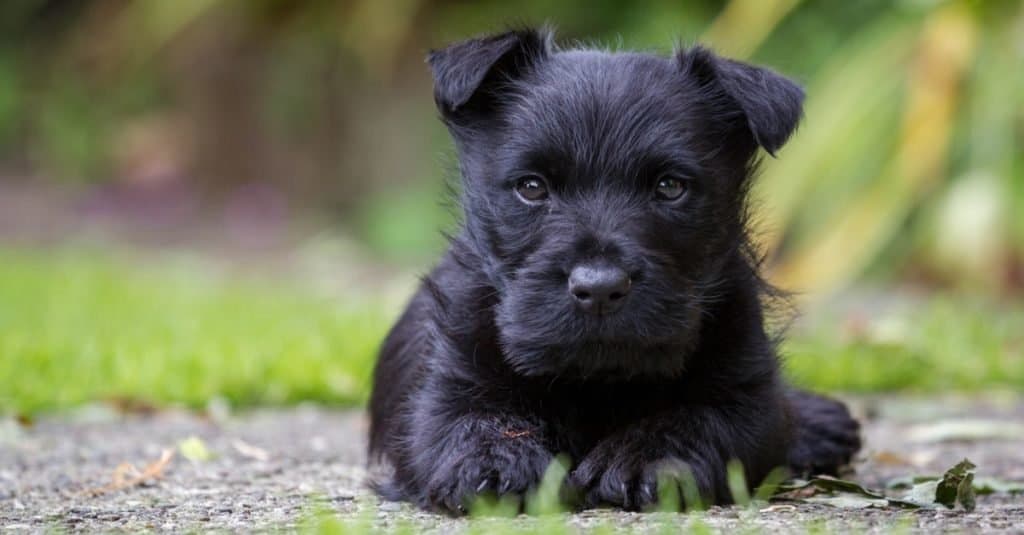
©Stephen Dukelow/Shutterstock.com
Scottish Terriers and Children
The Scottish Terrier is an excellent family dog that has a natural affinity for children. The only problem is that, because of its small size, the Scottish Terrier might not tolerate the noise and/or antics of smaller children. It may do best with older or more responsible children.
Similar Breeds
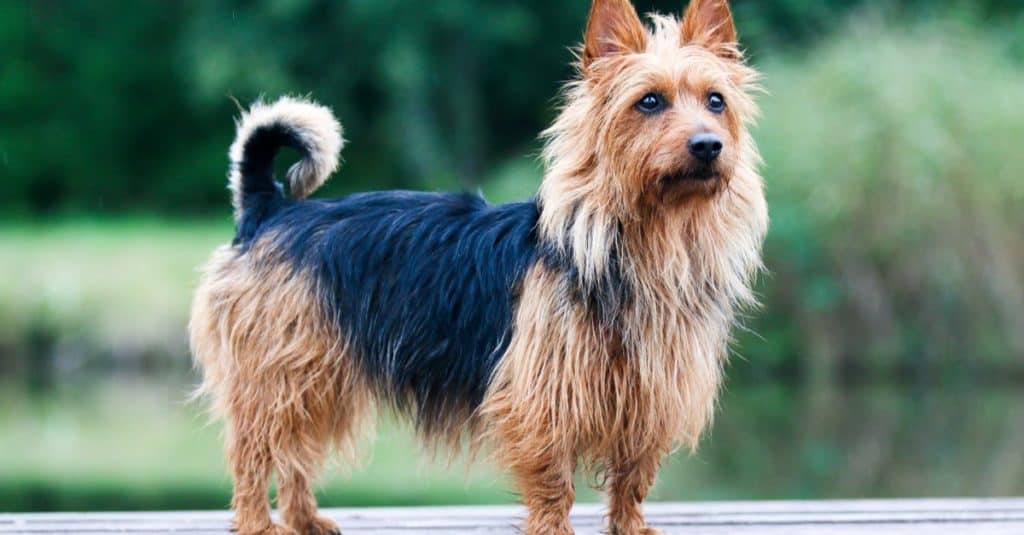
Australian Terriers have a similar temperament to Scottish Terriers
©Lisjatina/Shutterstock.com
The terrier group contains many dogs with similar appearances and personalities as the Scottish Terrier. Here are just a few examples of them:
- Australian Terrier – One of the smallest of all terriers, this dog has a curious, confident, and spirited personality. The coarse, wiry hair, especially around the face, is similar to that of the Scottish Terrier.
- Airedale Terrier – As the largest of all terriers, Airedale has been given the nickname “The King of the Terriers.” Originating from the Airedale Valley in north England, this breed displays all of the most recognizable traits of a traditional terrier, including serene self-confidence and bravery.
- American Staffordshire Terrier – The American Staffordshire is an atheletic, short-haired, bull-like variant of the typical terrier breed. Despite its different appearance, this breed still exhibits a high intelligence, as well as a confident, loyal, and good-natured personality that has inspired many to adopt thek. A mix of white, black, and tan markings are the most common, although more than 80% white is discouraged by breeders.
Famous Owners
The Scottish Terrier is a very famous breed that reached the heights of its popularity in the 1930s and 1940s. Dwight D. Eisenhower, Franklin Roosevelt, Queen Victoria, Humphrey Bogart, Jacqueline Kennedy Onassis, Rudyard Kipling, Bette Davis, and Lech Kaczyński (a former president of Poland) have all been the proud owners of a Scottish Terrier at some point. Roosevelt’s dog, Fala, was even immortalized with a statue at the former president’s memorial in Washington, DC. This dog also had a role in the 1955 animated film “Lady and the Tramp.”
Popular Names
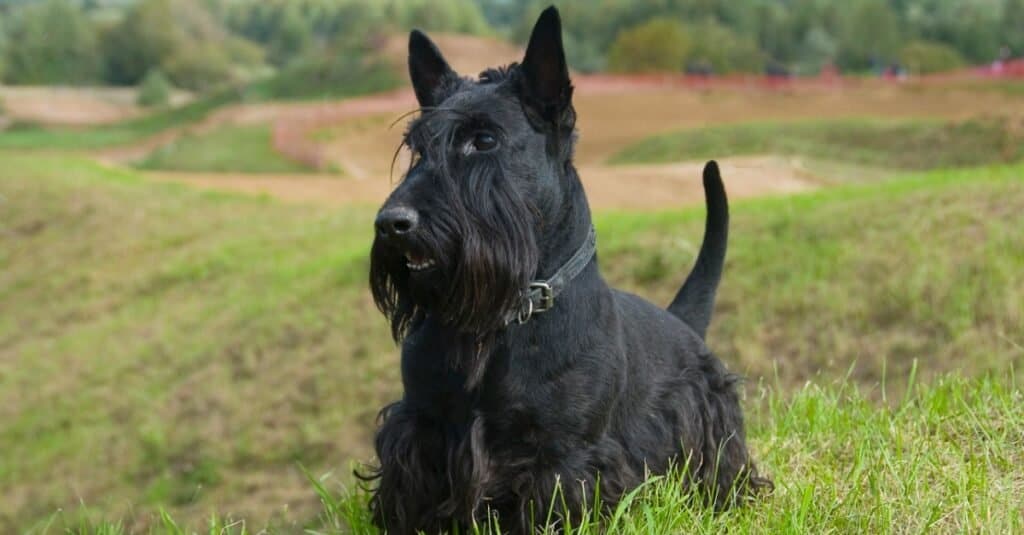
Scott, Angus and Ewan are some popular boy names for Scottish Terriers.
©iStock.com/kostya6969
If you are looking for a good Scottish Terrier name, then you might want to consider the following options:
- Lassie
- Laddie
- Connery
- Ewan
- Scott
- Alec
- Angus
- Archie
- Barclay
- Findlay
Scottish Terrier FAQs (Frequently Asked Questions)
What is a Scottish terrier?
The Scottish Terrier is a small vermin-hunting dog breed with a strong, confident, and independent personality. Potential owners may be attracted to the dog’s stout appearance and long, wiry fur, especially around the mouth and eyes.
Are Scottish Terriers good pets?
That depends on what you look for in a dog breed, but the Scottish Terrier is very friendly, playful, and affectionate toward anyone it trusts.
Do Scottish Terriers like to cuddle?
The Scottish Terrier can be quite friendly and affectionate, but they are not lapdogs and should be given their own space.
How much do Scottish Terriers cost?
A Scottish Terrier can cost as little as $300 to adopt, but the average price is more like $800. If you want your dog to have a particularly illustrious pedigree, then it will cost significantly more: perhaps thousands of dollars.
Can Scottish Terriers be left alone?
Each dog might be different, but the breed as a whole shouldn’t be left alone for too many hours, or else it might become anxious and bored.
What is the bite force of a Scottish Terrier?
This breed does not have a particularly strong bite force, at least compared to the bite force of many larger breeds. But it does have the tendency to bite or chew things. This can be dissuaded with the proper training.
What is the difference between a Schnauzer and a Scottish Terrier?
At first glance, Scottish Terriers and Schnauzers may seem very similar. However, the two breeds have key differences, including size, appearance, lifespan, guarding behavior, and trainability.
Thank you for reading! Have some feedback for us? Contact the AZ Animals editorial team.
Sources
- American Kennel Club / Accessed March 25, 2021
- American Kennel Club / Accessed March 25, 2021

